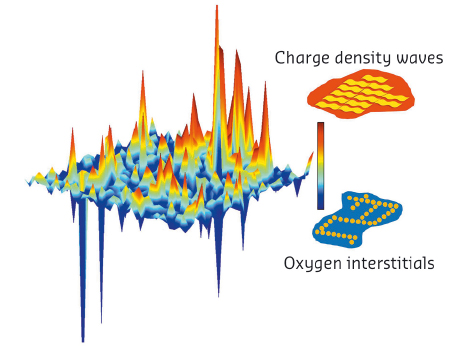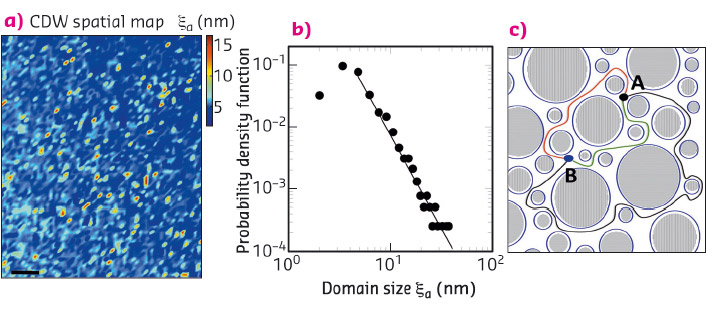- Home
- Users & Science
- Scientific Documentation
- ESRF Highlights
- ESRF Highlights 2015
- X-ray nanoprobe
- Intrinsic inhomogeneity of charge density wave order in cuprates and superconductivity at 95 K
Intrinsic inhomogeneity of charge density wave order in cuprates and superconductivity at 95 K
The emergence of non-Euclidean geometry at the mesoscale for superconductivity has been shown in a cuprate superconductor at optimum doping, using scanning micro X-ray diffraction. Direct evidence was found for the intrinsic inhomogeneity of the superconducting CuO2 plane. This experiment provided the imaging of the spatial distribution of charge density wave (CDW) puddles with a power law distribution of the CDW puddle size. The power law exponent of the distribution points toward a hyperbolic space for superconductivity.
A state of matter that allows a macroscopic quantum coherent condensate to resist the decoherence effect of high temperature is of interest for material science and other fields ranging from the physics of life, quantum biology and new quantum technologies such as quantum computing.
Standard BCS superconductors must be cooled to temperatures close to absolute zero to operate. A couple of decades ago, a ceramic material, La2CuO4+y doped by oxygen interstitials (O-i), was discovered to exhibit superconductivity around 40 K. This was followed by the discovery of other superconducting cuprate perovskites made of a CuO2 atomic layer intercalated with different spacer layers. The maximum superconducting critical temperature in a single layer of cuprate, Tc = 95 K, was achieved in HgBa2CuO4+y, by optimisation of the misfit strain between the CuO2 layer and the spacer layers. Following joint EXAFS and diffraction experiments, it was proposed that a new phase of matter, called superstripes, appears at optimum microstrain of the CuO2 plane and at optimum doping [1]. The superstripes phase is generated by the spontaneous breaking of both translational symmetry (CDW electronic crystalline phase) and gauge symmetry (superconductivity).
We have used an approach based on scanning synchrotron radiation diffraction measurements, carried out at beamline ID13 using a focussed microbeam. The CDW size distribution and their spatial arrangement has been determined at the nanoscale and the mesoscale. We studied the tetragonal HgBa2CuO4+y doped by oxygen interstitials with Tc = 95 K.
 |
|
Fig. 10: Spatial anti-correlation of charge density wave order (CDW puddle rich regions in green to-red) and oxygen interstitial stripes density (green to blue) on a 30 x 30 µm2 area of HgBa2CuO4+y. |
We visualised the oxygen interstitials (O-i) in the spacer layers HgBa2O2+y, already observed in other cuprates [2-4]. The oxygen interstitials introduced as dopants form atomic stripes of defects that are anti-correlated with electronic CDW puddles forming inhomogeneous patterns as shown in Figure 10. We found that electrons form short range CDW puddles, as reported recently for many cuprates [5], at temperatures lower than 240 K. At 100 K, near the onset of superconductivity, the size of the CDW puddles in the CuO2 plane shows a power law distribution as shown in Figure 11.
 |
|
Fig. 11: (a) Spatial map of the CDW puddles size (scale bar 10 µm) and (b) Probability density function (PDF) of the CDW puddles size. c) Pictorial view of the superconducting current running in the interface space between CDW puddles. |
Therefore, the CDW puddles introduce a significant topological change in the available space for the free electrons that do not crystallise, making Cooper pairs flow in the interstitial space outside of the CDW puddles at low temperatures. In this landscape, electrons that go from a point A to a point B can take different paths that cannot be topologically deformed one into the other. Figure 11 shows possible paths taken by electrons at the Fermi level running in the interfacial space outside of the CDW puddles. These paths go around the CDW puddles in different ways creating non-trivial paths for electrons which are mapped into a hyperbolic space for a system of puddles with power law distribution.
In conclusion, we have found an intrinsic inhomogeneity in a tetragonal cuprate perovskite with a very high critical temperature, Tc = 95 K, both in the spacer and in the active superconducting layers. It is known that random disorder suppresses the critical temperature, but here the oxygen interstitials form a correlated quenched disorder of atomic wires in the spacer layers. The O-i rich zones are anti-correlated with CDW nanopuddles in the CuO2 plane showing a power law distribution, as has already been found in La2CuO4+y [4]. The emerging complex phase separation at the mesoscale shows a spatial charge distribution resulting from competition between O-i rich domains and CDW puddles where the interface space between CDW puddles (loci of superconductivity) shows an emergent non-Euclidean hyperbolic geometry favouring superconductivity.
Principal publication and authors
Inhomogeneity of charge density wave order and quenched disorder in a high Tc superconductor, G. Campi (a,b), A. Bianconi (a,b), N. Poccia (b,c), G. Bianconi (d), L. Barba (e), G. Arrighetti (e), D. Innocenti (b,f), J. Karpinski (f,g), N.D. Zhigadlo (g), S.M. Kazakov (g,h), M. Burghammer (i,j), M. v. Zimmermann (k), M. Sprung (k) and A. Ricci (b,k), Nature 525, 359 (2015); doi: 10.1038/nature14987.
(a) Institute of Crystallography, CNR, Monterotondo Roma (Italy)
(b) Rome International Center for Materials Science, Superstripes, RICMASS, Roma (Italy)
(c) MESA+ Institute for Nanotechnology, University of Twente, Enschede (Netherlands)
(d) School of Mathematics, Queen Mary University of London (UK)
(e) Institute of Crystallography, Sincrotrone Elettra UOS Trieste (Italy)
(f) EPFL, Institute of Condensed Matter Physics, Lausanne (Switzerland)
(g) ETH, Swiss Federal Institute of Technology Zurich Laboratory for Solid state Physics (Switzerland)
(h) Department of Chemistry, M.V. Lomonosov Moscow State University (Russia)
(i) ESRF
(j) Department of Analytical Chemistry, Ghent University (Belgium)
(k) Deutsches Elektronen-Synchrotron DESY, Hamburg (Germany)
References
[1] A. Bianconi, Int. J. Mod. Phys. B, 14, 3289 (2000).
[2] N. Poccia, et al., PNAS (USA) 109, 15685-15690 (2012).
[3] G. Campi et al., Phys. Rev. B, 87, 014517 (2013).
[4] M. Fratini et al., Nature 466, 841-844 (2010).
[5] E.W. Carlson, Nature 525, 329–330 (2015).



